Where did the top decision makers of the largest companies go to college?
The largest 500 companies in the world that comprise the Global Fortune 500 employ thousands of executives around the world.
Have you ever wondered what academic affiliations and degrees these executives obtained on their way to the top?
We wondered too, so, this past month, in March 2022, we turned to our continuously updated database of organizational charts for the world’s largest companies.
We found, on average, 203 top executives per company as of March 2022 – and we did find some common denominators both in collegiate names and degrees among these business leaders, which we report below.
Hall of Power
This survey, however, focuses on a narrower group of executives—what we call “the hall of power,” comprised of the inner circle of executives at the very top of the world’s largest companies, including the chief executive officer (CEO), the executives directly reporting to the CEO, and members of the company’s board of directors.
Pruned in this way, we found our list of 203 executives per company was pruned to 20 executives per company for a total of 10,011 executives globally as of March 2022.
1. Where executives went to school
Our data for these 10,011 executives reveals a total of 1,246 college affiliations for them. Among this, 27% studied at one of the top 30 colleges and 84% studied at one of the top 500 colleges (click here to download the 500 top colleges and their ranking).
Our biographical data on these executives reveals that they completed their degrees between 1962 and 2021 and, on average, in 1992 (30 years ago). The university landscape then was, of course, different from today.
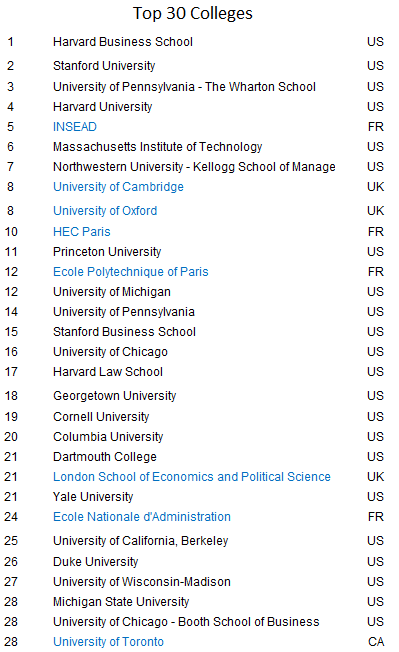
2. Differences between CEOs and the board
When looking at the very top of the organizational chart, CEOs were more likely to attend local prestigious universities when compared to board members.
Board members were much more likely to have attended United States-based colleges as opposed to CEOs and their direct reports. Among CEOs and board members, these were the leading college affiliations:
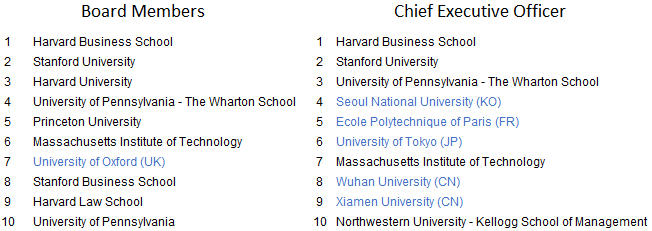
3. C-Functions reporting to the CEOs are more specialized
Among the C-functions reporting to one of the 500 CEOs, executives were found often to have obtained a specialized collegiate education.
For example, executives may have attended Stanford or MIT to study R&D, technology, or manufacturing; others may have attended Harvard Law School, Columbia Law School, or Georgetown Law School for a legal education.
Among varying executive functional roles, these executives were most commonly found to have attended the following colleges (ranked in order):
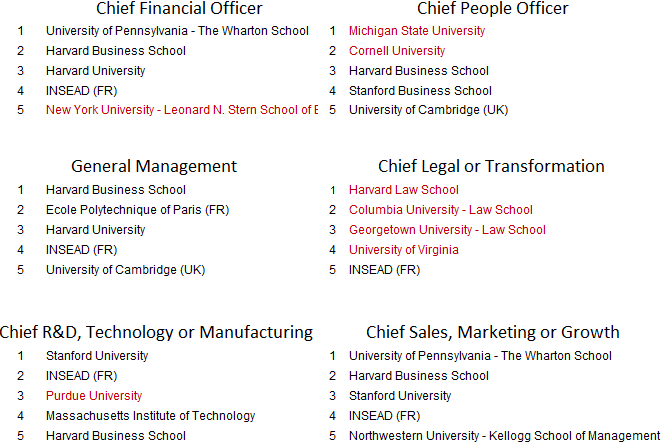
4. Strong regional players within each region
When looking within companies headquartered in various regions, local universities dominate.
Decades ago, most universities almost exclusively recruited within their home country for their students and their faculties constraining their influence.
Outside of U.S. universities, only INSEAD located in France (and created in 1957) has a record of sizable international recruitments since its inception.
Among companies headquartered in each geographic region, these are the most common collegiate affiliations for top executives:
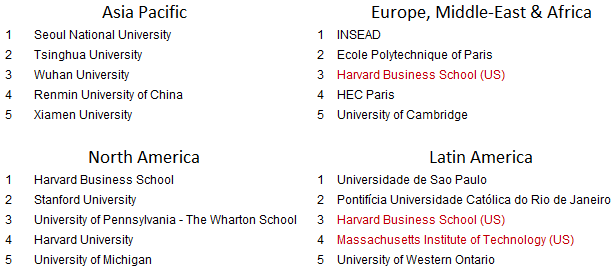
5. U.S. education dominates every industry
When looking at the world’s main industries, our data reveals that U.S. colleges are still far and away most common for the world’s top executives.
Perhaps most impressive, Harvard Business School is found as the first or second most common collegiate affiliation in every major industry.
Some colleges have brand identity for preparing students for success in certain industries; for example, HEC Paris is popular in the luxury goods industry, and the University of Cambridge in the UK is commonly recognized for preparing top business leaders in finance.
Among the top six leading industry sectors, top executives in these industries were found to have attended the following colleges (ranked by popularity):
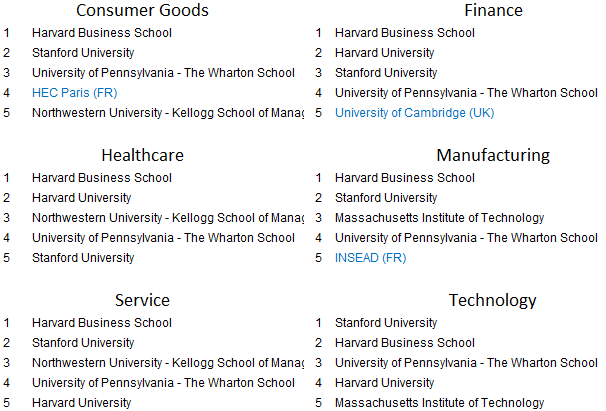
6. Harvard is first
Harvard was the first university established in the U.S. Harvard was first, but opened humbly on October 6, 1636 with just one professor and nine students.
Today (386 years later), Harvard is a proven leader in producing top executives with six of its schools ranking in our top 50 globally:

7. Six colleges are running ahead
For the Global Fortune 500, when extending from the 20 top executives to all key executives (again, we have recorded 203 on average per company for this extended list), the top 10 schools remain exactly the same as they were for the top 20 executives, only their ranking changes.
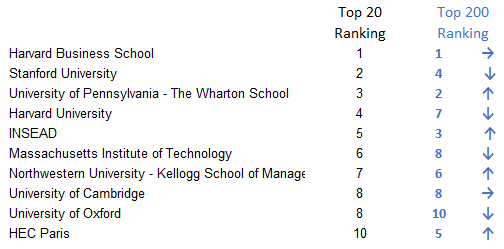
The unicorns can be considered as representing the next generation of Fortune 500 executives, even if some might fail.
There are 1,020 unicorns globally as of March 2022 for which we list 19 executives on average.
When looking at the top 10 schools for this list, our data reveals that four are unique (indicated in bold) when compared to the top 10 of the Global Fortune 500, coming not surprisingly mainly from Silicon Valley and Israel:
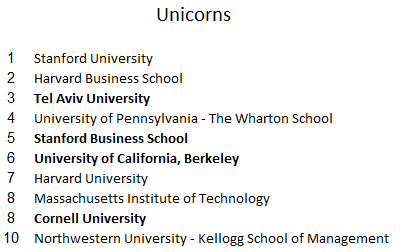
To summarize, six colleges consistently make the top 10 (alphabetical order):
• Harvard Business School,
• Harvard University,
• Massachusetts Institute of Technology,
• Northwestern University – Kellogg School of Management,
• Stanford University, and
• University of Pennsylvania – The Wharton School.
8. Many other ways to reach the top
Even for the best of the best, Harvard Business School (HBS) places less than 2% of its carefully selected students trained by its world-class faculty in these 10,000 top executive positions.
The age brackets for these positions are between 45 and 65 years old.
But HBS does not supply a limitless number of graduates. HBS was graduating only 800 students a year. Over 20 years, this means that roughly 16,000 HBS students are eligible (20 x 800).
At any given moment in time, roughly 200 to 250 top executives are found to be HBS alumni. For all the other universities, the odds are much less favorable.
Elite Competition
A US-based education dominates the educational profile of current top executives.
Oftentimes, there are close ties between alumni from these schools. Most alumni enjoy developing these connections and contributing to the development of their alma mater.
Today most colleges around the world recruit across borders for their students and their professors.
English has become the education lingua franca around the world, creating new sets of competitors for the US institutions.
Even if college rankings may look static over the years, the competition among elite institutions will rage on.
Methodology:
The executive data have been extracted as of March 2022 on the Global Fortune 500 list (click to download) issued in July 2021 from The Official Board data base.
Each executive curriculum has been collected and parsed from several publicly available sources (list available on The Official Board).
Whenever possible, we looked at individual schools within universities( e.g., Harvard Business School or Harvard Law School vs. Harvard University). Notice any errors or want to hear more? Reach out to us by email at: [email protected].